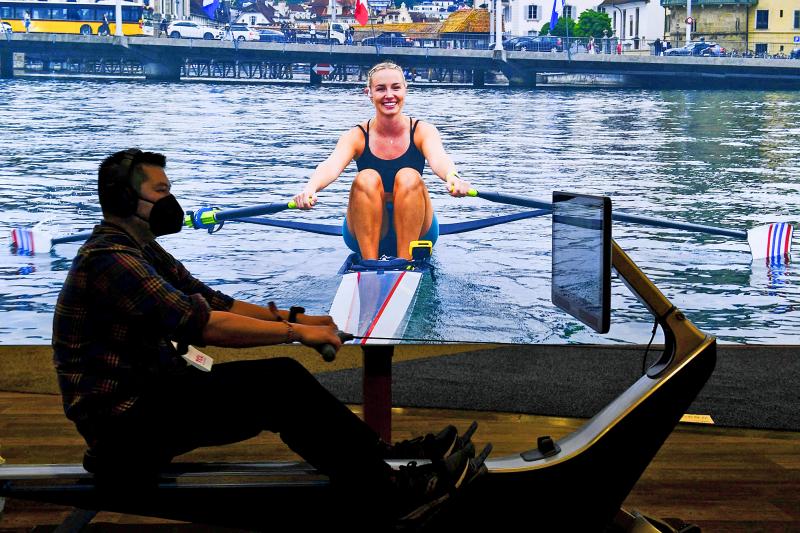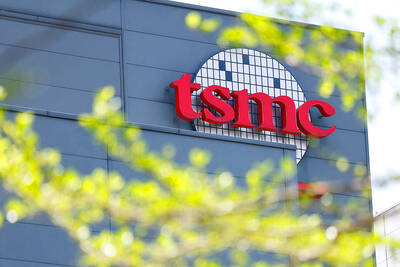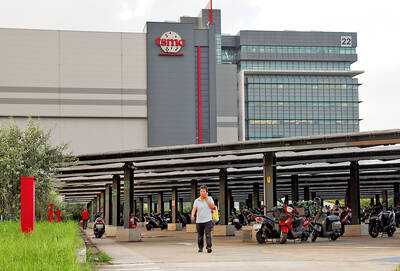Interactive comment sections and virtual reality headsets: Internet-connected fitness gear and services have boomed during the COVID-19 pandemic as at-home athletes seek a proxy for gym life.
While home workouts long predate COVID-19, they have taken on a social aspect that looks set to become the standard in a world reshaped by the pandemic.
“A big part of going to the gym together is sort of suffering together ... you build a camaraderie around that,” Jeremy Needham, who does customer education for US boxing fitness company Liteboxer, told reporters at the Consumer Electronics Show (CES) in Las Vegas, Nevada.

Photo: AFP
“And now that we don’t share that space, at least in real time, we have to do it virtually,” he added.
Like other companies that sell Internet-connected fitness gear, Liteboxer offers customers access to workouts, competitions and other features for a monthly charge — on top of the roughly US$1,200 wall-mounted machine.
The market for fitness tech has been growing for years, but the industry has gotten a boost in the past couple of years, similarly to how the pandemic accelerated e-commerce and remote working trends.
“Connected equipment exploded onto the scene in a big way as consumers had to shift the way to work out during the pandemic,” CES organizer Consumer Technology Association (CTA) said in an industry forecast.
Internet-connected exercise equipment was a nearly US$3.8 billion market last year, and double-digit percentage growth is expected this year, the CTA’s forecast said.
“[Customers] want connectivity,” CTA analyst Richard Kowalski said. “They want to engage with other people online.”
Connected rowing machine maker Hydrow allows customers to comment and like others’ workouts, and users have developed their own social media groups.
“You start talking to each other and then all of a sudden, you have a group of maybe six guys, you know, from all over the world,” Aquil Abdullah, who leads workouts on the system, told reporters. “A guy is in London, a guy is out in California, a guy is down in Florida, and you have this community.”
The machines, which sell for US$2,295, have the usual rowing bar and seat, but also a screen that allows clients to exercise along with instructors on the water, in locales from Miami to London.
However, the connected fitness industry has shown some sensitivity to the changing conditions of the pandemic and the way it affects equipment users’ lives.
Fitness firm Peloton Interactive Inc’s shares have been under pressure since early November, when the company cut its forecast as more consumers returned to reopening gyms. Credit Suisse Group AG downgraded the firm last month, saying the market shifts have forced Peloton to increase advertising and discounting.
However, as cases of the Omicron variant of SARS-CoV-2 break records around the world, many are again hunkering down at home.
That shift could work in favor of home fitness tech companies.
The CTA took a bullish perspective, saying: “The growth trajectory suggests that health-conscious consumers are finding practicality and convenience in exercising at home, even as gyms and workout classes reopen.”
Exercise of any kind has offered some people a relief from the pandemic’s effects — as work, school and travel disruptions and simmering health worries offer plenty to stress about.
“The pandemic locked us inside ... we couldn’t do the things that we loved,” Needham said. “But the human body still needs cardiovascular activity, it’s quite simple. You just need a really engaging way ... to release that energy that builds up in you.”

TECH TITAN: Pandemic-era demand for semiconductors turbocharged the nation’s GDP per capita to surpass South Korea’s, but it still remains half that of Singapore Taiwan is set to surpass South Korea this year in terms of wealth for the first time in more than two decades, marking a shift in Asia’s economic ranks made possible by the ascent of Taiwan Semiconductor Manufacturing Co (TSMC, 台積電). According to the latest forecasts released on Thursday by the central bank, Taiwan’s GDP is expected to expand 4.55 percent this year, a further upward revision from the 4.45 percent estimate made by the statistics bureau last month. The growth trajectory puts Taiwan on track to exceed South Korea’s GDP per capita — a key measure of living standards — a

Samsung Electronics Co shares jumped 4.47 percent yesterday after reports it has won approval from Nvidia Corp for the use of advanced high-bandwidth memory (HBM) chips, which marks a breakthrough for the South Korean technology leader. The stock closed at 83,500 won in Seoul, the highest since July 31 last year. Yesterday’s gain comes after local media, including the Korea Economic Daily, reported that Samsung’s 12-layer HBM3E product recently passed Nvidia’s qualification tests. That clears the components for use in the artificial intelligence (AI) accelerators essential to the training of AI models from ChatGPT to DeepSeek (深度求索), and finally allows Samsung

READY TO HELP: Should TSMC require assistance, the government would fully cooperate in helping to speed up the establishment of the Chiayi plant, an official said Taiwan Semiconductor Manufacturing Co (TSMC, 台積電) yesterday said its investment plans in Taiwan are “unchanged” amid speculation that the chipmaker might have suspended construction work on its second chip packaging plant in Chiayi County and plans to move equipment arranged for the plant to the US. The Chinese-language Economic Daily News reported earlier yesterday that TSMC had halted the construction of the chip packaging plant, which was scheduled to be completed next year and begin mass production in 2028. TSMC did not directly address whether construction of the plant had halted, but said its investment plans in Taiwan remain “unchanged.” The chipmaker started

MORTGAGE WORRIES: About 34% of respondents to a survey said they would approach multiple lenders to pay for a home, while 29.2% said they would ask family for help New housing projects in Taiwan’s six special municipalities, as well as Hsinchu city and county, are projected to total NT$710.65 billion (US$23.61 billion) in the upcoming fall sales season, a record 30 percent decrease from a year earlier, as tighter mortgage rules prompt developers to pull back, property listing platform 591.com (591新建案) said yesterday. The number of projects has also fallen to 312, a more than 20 percent decrease year-on-year, underscoring weakening sentiment and momentum amid lingering policy and financing headwinds. New Taipei City and Taoyuan bucked the downturn in project value, while Taipei, Hsinchu city and county, Taichung, Tainan and Kaohsiung